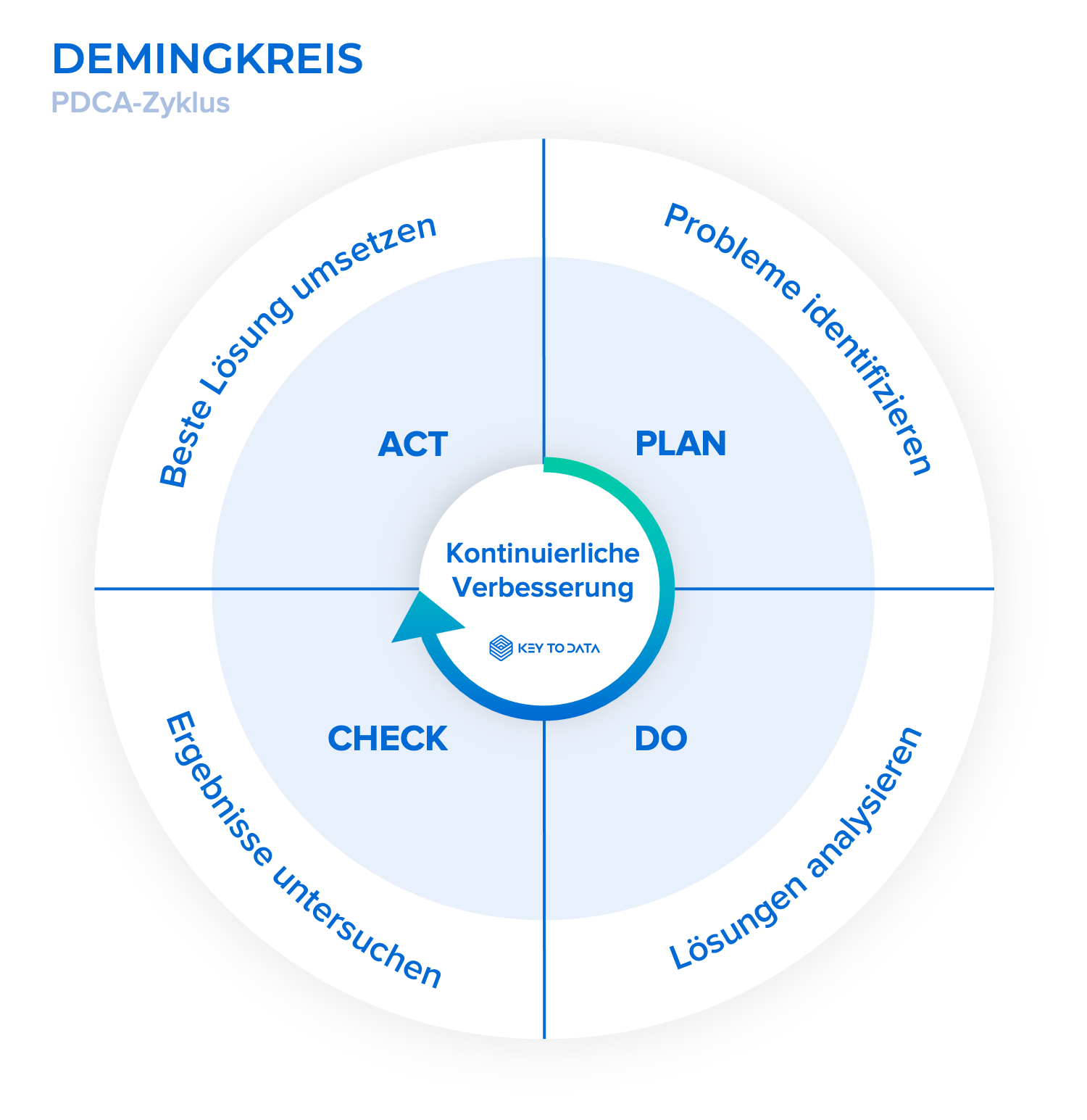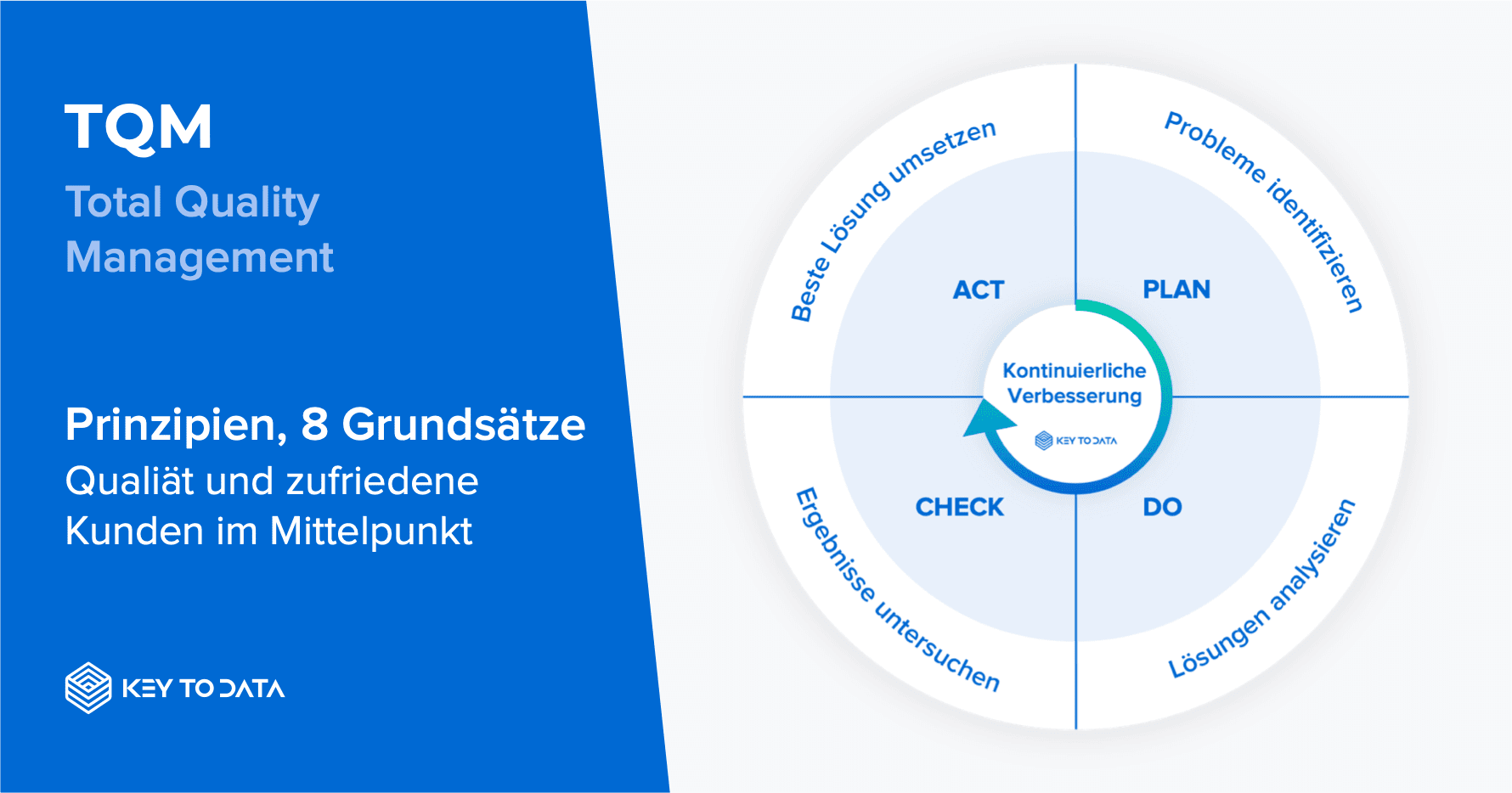TQM
Total Quality Management
Definition
Total Quality Management (TQM), also called comprehensive quality management, is a holistically oriented QM method that focuses on quality with the participation of all employees. In doing so, long-term business success as well as the benefit for the members of the company and for society are pursued through customer satisfaction.
History
USA
The American professor William Edwards Deming researched quality management in the 1940s. In view of the great destruction after the Second World War, little attention was paid to it in the USA. The focus was rather on increasing production as much as possible. Total Quality Management was more popular in Japan and as early as 1951 a Japanese company was awarded the Deming Prize for the first time.
Japan
The Japanese successfully pursued the strategy of comparatively low prices coupled with high quality. Due to the resulting increase in Japanese market share, Deming's methods attracted the interest of companies from the USA. Between 1970 and 1980, Deming's philosophy was also adopted by larger companies in the USA. Through his efforts to improve quality in companies, Howard Malcolm "Mac" Baldrige Jr., who worked for the Secretary of Commerce from 1981 - 1987, helped Deming's QM method gain national recognition. From 1987 to the present, the Baldrige Award has been presented annually to organisations with high quality standards. The award is based on TQM principles and is continuously developed through surveys of companies.
Europe
EFQM
In 1988, 14 companies adapted the concept of the award and founded the European Foundation for Quality Management (EFQM), whose goal is the realisation of a European model for quality management. The EFQM model for business excellence is still being continuously developed today, with input from the field. A quality award was presented in Europe for the first time in 1992.
ISO
In 1994, the ISO (International Organisation for Standardization) published the DIN EN ISO 9004 guideline in the "9000 series" (guidelines and standards for quality management) and interprets the EFQM model using a TQM model. In the meantime, the ISO guideline is recognised as an alternative model and was updated in 2018. ISO Business Excellence, on the other hand, does not award a prize and no certifications are available.
TQM principles
The basic principles of the TQM philosophy have quality as a defining element in common. The TQM principles are listed below:
Quality
- is oriented towards the customer,
- is achieved by employees from all areas and at all levels,
- includes several dimensions, which have to be operationalised by criteria,
- does not represent a goal, but is a permanently ongoing process.
- refers to both products and services, but fundamentally to the processes necessary for production,
- must be worked out and requires active action.
Germany: The most widely used TQM concept in Germany is the EFQM Model for Excellence of the European Foundation for Quality Management. This model has a holistic, results-oriented approach. The criteria of this model are used to award the most important German quality prize, the Ludwig Erhard Prize.
TQM Model: Meaning
8 TQM principles
TQM is divided into eight principles, which form the basis of the TQM philosophy. The approach is similar in all models: Quality management should be defined by the relationship between the company and the customer and not be limited solely to technical functions to ensure product quality. According to the American businessman and author Philip B. Crosby (June 18, 1926 - August 18, 2001), quality represents the fulfilment of requirements. The primary goal is customer satisfaction, which can only be ensured if the company develops itself in the long term. The EFQM model functions as a checklist in which the interdependencies in a company are to be depicted.
The TQM model is divided into the following eight principles:
Customer orientation
As an organisation depends on its customers, it should understand the current and future needs of its customers, meet their requirements and aim to exceed their expectations.
Leaders
The consistent definition of goals and the alignment of the organisation are the responsibility of managers. They should ensure the creation and maintenance of internal frameworks so that employees can fully focus on achieving organisational goals.
Involve employees
At all levels, employees are the primary factor of an organisation. Their skills can be used to the best advantage of the organisation through comprehensive involvement.
Process orientation
By managing and directing activities and the associated resources in the form of a process, a desired goal can be achieved more efficiently.
System-oriented management
Recognising, understanding and managing processes that interact with each other as a system helps to achieve the organisation's goals effectively and efficiently.
Continuous improvement
One task of the organisation should be the continuous improvement of all services through learning and innovation.
Factual decision making
An effective decision is data-based and is made by analysing data.
Mutually beneficial relationships with suppliers
There is a dependency relationship between an organisation and its suppliers. Value creation is increased through mutually beneficial relationships.
The TQM principles are to be implemented using the RADAR logic (EN: Results, Approach, Deployment, Assessment, Review | DE: Results, Approach, Implementation, Assessment, Improvement). Thus, a company has to define the desired results at the beginning, then work out the procedure for implementation, then realise the implementation and subsequently assess and review the procedure for effectiveness and the implementation for efficiency. The guiding principle of the model is the permanent comparison of one's own actions and results with the best competitors. Furthermore, the five ways of thinking (proactive, sensitive-intuitive, holistic, potential-oriented, economic) can be considered essential for this methodology.
Implementation
In general, the model can be used by any company, there is no dependence on industry or size. According to Liedtke, it has been shown in Switzerland, for example, that small and medium-sized companies are quicker to adapt the model. Until large companies develop into organisations that can demonstrate comprehensive quality with associated results, more than six years should be planned. In large corporations, the Excellence Model can also be applied individually to individual units, divisions and departments. Liedtke defines the personal commitment of top managers as the most important factor for successful implementation.
Benefit
A detailed study of the EFQM model's benefits has not yet been carried out. In the USA, on the other hand, scientific studies of the Excellence Model applied there have shown that these companies perform better than their competitors in the following points:
- Turnover and profit
- Productivity
- Share value
- Generate jobs.
In 2010, Vinod Singhal (Georgia Institute of Technology) and Kevin Hendricks (University of Western) impressively demonstrated in a five-year long-term study that the performance of approximately 600 winners of quality awards was significantly better than the companies in a comparison group. They measured the results using KPIs (Key Performance Index):
- Share price 44% higher
- Turnover higher by 37%
- Operating income higher by 48%.
Disadvantages
One obstacle to the introduction of TQM can be the corporate culture that needs to be changed. In the context of a fast-changing economy and short-term profit motives, it can be difficult to establish quality as a corporate philosophy.
Comparison: Classical QA and TQM
Comparison of the factors people, processes, suppliers and customers between traditional quality assurance and the TQM model.
Classic quality assurance | Total Quality Management |
| People make mistakes | Processes provoke errors |
| Individual employees are responsible for mistakes | All employees are responsible for mistakes |
| Zero error is not realisable | The goal is zero error |
| Purchasing from many suppliers | Few suppliers as partners |
| Customers must take what the company offers in terms of quality | Everything is designed for complete customer satisfaction |
PPAP Excel-Template
Free of charge | English | Complete
50% time saving in Inspection Report generation. Publish Inspection Reports according to VDA, PPAP, AS9102 or custom templates.
Free access for 14 days
Inspection reports in minutes, not hours
- Free training & support
- Full functionality


